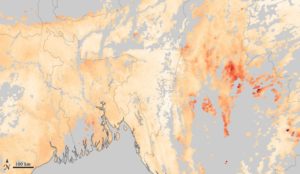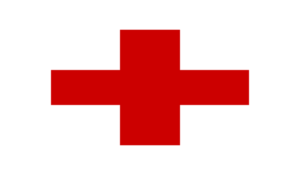The remote sensing is one of the most important tools available for regional planning. Remote sensing not only aids in making a planning process, but it is also aids in mapping and detecting various types of hazards when a detailed description of their effects is not available. If the probability of a natural hazard occurring can be determined in the early stages, measures can be implemented to reduce the economic and social impact of potential disasters.
All-natural hazards are responsive to some degree for study by remote sensing as all hydrologic, geologic, and atmospheric hazards create situations that recur or leave evidence of their previous occurrence. This evidence is analyzed, recorded, and can be integrated into the planning process.
Disasters and its various types
Some common type of disasters are as follows:
1. Environmental disasters: They involve industrial and technological accidents, usually including the transportation of production of hazardous materials. For instance, forest fires and oil spills caused by humans.
2. Natural disasters: These involve floods, tornadoes, earthquakes, volcano eruptions, and hurricanes. They have a hazardous impact on human health and also have secondary impacts, such as fires and landslides that cause further suffering and deaths.
3. Pandemic disasters: They include disasters that involve the spread of contagious disease that disrupts ongoing business and services and strongly affects health. Such disasters cause a lot of social and economic costs. Some examples of pandemic disasters are the SARS outbreak and dengue spread.
4. Complex disorders: They include breaking down of authority, attacks on strategic installations, and looting. A few examples include coup and war.
Any of the above-mentioned emergencies or disasters can disrupt services such as transportation, water provision, and communication. This sudden disruption results in consequences to social networks and health. Moreover, these disasters have a long-lasting effect on people’s life after the mitigation of the initial impact. So, poorly planned relief activities can negatively impact the disaster victims.
Recent years have seen an increase in the magnitude and frequency of natural disasters. These disasters have a negative impact on sustainable development by altering social, environmental, and economic impacts. Thus, it is imperative to develop effective and sophisticated tools for disaster management.
The role of remote sensing in disaster management
Remote sensing through satellite imagery and geographical information system (GIS) aids in providing a wealth of information to the disaster and emergency officials for analysis and assessment of natural disasters. High resolution, temporal and spatial, satellite imagery applications such as forest fire detection and flood monitoring can be helpful for initiating effective response in case of an occurrence of an actual disaster. Natural disasters occur with little or no warning at all, which results in the loss of life and cause extensive damage to the local economy and property.
The biggest challenge to date, which is faced by the government, is developing an effective plan during disasters. Estimation of a particular place and land that is prone to a natural disaster can help to better analyze the particular area’s vulnerability and risk. This informative insight can equip planners and operators with adequate knowledge so that they can prioritize target mitigation and required activities for those areas.
Furthermore, human rescue operations are the most challenging and critical issue in contingency planning. In such dynamic scenarios, the first people to respond to any disaster are individuals in that particular community. With appropriate insights, these individuals can be helped to better equip and strengthen themselves to resist the disaster.
Both satellite and aerial remote sensing technologies are available, satellite-derived remote sensing techniques are majorly used as it provides a synoptic view that is essential for developing planning studies. Aerial remote data is majorly used for natural hazard management when the focus of disaster management planning is to focus on the priority areas, providing information that is too small to detect in satellite imagery, and verifying small-scale data verifications. However, extensive use of aerial remote sensing technique involves budget constraints, especially during the initial stages of a study.
How does remote sensing help in disaster management?
Spatial analysis and GIS aids in designing a highly accurate interactive system that provides a comprehensive understanding of disasters, damage caused by them, and their outcomes. The geographical information system can act as a decision support aid as all disasters are spatial in nature. With detailed information obtained through various GIS layers, decision making has become simpler. Now it is possible to effectively plan a response to emergency conditions, which can also be internally evaluated. This information is critical for a quick and effective response to any emergency disaster. Remote sensing is thus becoming ubiquitous in disaster response, preparedness, and recovery missions.
Remote sensing helps in managing a disaster at various stages as follows:
1. Prevention: Remote sensing helps in managing huge data that is essential for hazard and vulnerability assessment of the area.
2. Preparedness: Remote sensing acts as a useful tool for meticulous planning of evacuation roots and designing areas for emergency operations in part of the city where it is required and suitable.
3. Relief: When GPS is used along with GIS, it provides useful information essential for rescue and search operations. This is critical as every minute is so valuable that it can make a difference in life and death.
4. Rehabilitation: Here remote sensing aids in organizing the damage information and provide with essential insight for future use. The available post-disaster census information and analysis data of sites for reconstruction can be centralized and managed efficiently.
Role of remote sensing in disaster mapping

Disaster mapping is drawing areas that have undergone excessive damage, either due to manmade or naturally occurring troubles, which has resulted in the loss of property, life, and infrastructures. Disaster mapping shows disaster impact zones as well as risk zones. Remote sensing devices such as aerial photographs and satellite images, it is easier to define the area that is damaged by a disaster. In contrary to manual maps, which can be inefficient and tedious, remote sensing is very effective as the prepared maps can be digitized and stored in computers by using tailormade geographic information system software.
In conclusion, major scientific advancement has made it easier to carry out emergency operations efficiently. Remote sensing, with techniques like GIS and spatial analysis, have made it easier to manage disaster by making it easier to understand them in regard to prone locations. It also helps in zoning areas according to the risk magnitude. All this has made it very easy for emergency officials to plan and execute operations at all the stages of disaster management. With an increase in disasters, remote sensing has become ubiquitous in managing them to minimize human and economic loss due to them.



